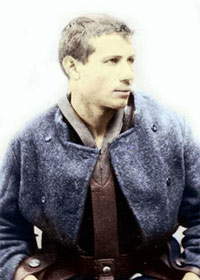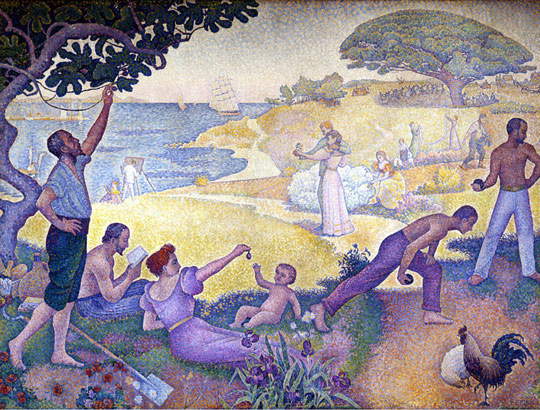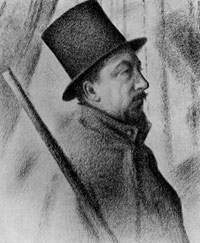Art and anarchy: Paul Signac and his Au temps d'harmonie
It was June 24, 1894, when, in Lyon, Italian anarchist Sante Caserio murdered French Republic President Marie-François Sadi Carnot with a stab wound to the heart. They did not have time to pass two months that Sante Caserio, immediately captured after the assassination attempt, was executed, also in Lyon, on August 16. As with Gaetano Bresci a few years later, for Sante Caserio it was not an attempt to kill a person: it was a blatant gesture to try to bring down a principle. Caserio, before being executed, wrote from prison a letter to his mother, to whom he reaffirmed his love and to whom he said: if I committed this deed of mine it is precisely because I was tired of seeing such an infamous world.
 |
| Sante Caserio |
Before Sante Caserio it had been the turn of Auguste Vaillant, executed on February 5, 1894, by guillotine for planting a bomb at the Chamber of Deputies in Paris. In May of that year, on the other hand, 22-year-old Émile Henry, who had thrown a bomb at the Gare Saint-Lazare, was executed. Two years earlier, receiving the death sentence was the illegalist anarchist Ravachol, perpetrator of numerous bombings and robberies (illegalism admits illegal acts such as theft and robbery if conducted in order to redress the injustices of capitalism). For France, this was an unprecedented series of attacks: they were the fruits of the actions of anarchists who believed ininsurrectionalism, or that form of anarchism which stipulates that the state should be overthrown through violent uprisings: however, this is a tendency that has often been criticized by other currents of anarchism.
Because of the actions of these characters, who were often driven by individual impulses and therefore did not belong to any organized group, repression against anarchists in France was not tender. Partly for this reason, the great artist Paul Signac (1863 - 1935) was forced to revise an important painting he was working on in those years, known today as Au temps d’harmonie. L’âge d’or n’est pas dans le passé, il est dans l’avenir (“In the Time of Harmony. The golden age is not in the past, it is in the future.”). The title Signac had in fact envisioned for the work was different: the first part of the painting’s name should have been Au temps d’anarchie, meaning “At the Time of Anarchy.” However, given the recent news events, the artist perhaps thought it more prudent to change the title while the work was in progress. The painting was begun in 1893: the artist had recently moved to Saint-Tropez, where he came into contact with many other artists and intellectuals, such as Henri-Edmond Cross, Maximilien Luce, Théo Van Rysselberghe, and later Henri Matisse as well. His stay in Saint-Tropez was crucial for Signac: here he experimented extensively with thewatercolor technique, and the warm, enveloping light of the town helped to brighten his palette.
 |
| Paul Signac, Au temps d’harmonie; oil on canvas, 300 x 400 cm; 1893-1895; Montreuil, City Hall |
Au temps d’harmonie (or d’anarchie for those who prefer the original title) is set in Saint-Tropez itself. It is a political manifesto of sorts and succinctly encapsulates Paul Signac’s anarchist ideas (to which, however, it will be appropriate to return with another post). The goal ofanarchy is to create a society where people can live in harmony (hence, therefore, the second title of the work), where people can spend their existence carefree and doing what they love, and where there are no differences of class, census, and whatever else. This is the goal of every anarchist idea, despite the fact that part of public opinion has been accustomed to associating anarchy with chaos: nothing more unfounded, wrong, and obnoxious. Anarchy is harmony, because the lack of a form of government drives men to organize harmoniously, breaking down social barriers.
We see this well in Signac’s painting. In the foreground, a man, abandoning a scythe and shovel on the ground, plucks a fig from a tree: this is a self-portrait by Paul Signac. Near him, a woman (his wife Berthe Roblès) gives a fig tree to a child. Further back, a man is reading, and beside him two other men are playing boules. Back, there are a couple in love embracing and a woman who seems to be picking flowers from a bush. In the distance we see a painter at work with canvas and easel, and in the water a group of boys diving into the sea. In the background, farm machinery mows the fields and a group of jubilant, jubilant people improvise a dance around a maritime pine tree. The reason for this last detail is simple: Signac sees technological progress, represented by machines, as a liberation, in the sense that machines can do the work instead of man (and indeed the character representing Signac lays scythe and shovel on the ground) and thus leave people more time to devote to their favorite activities. These were hot topics in those years, and Signac wanted to show that there is an alternative to capitalism that uses progress to centralize wealth in the hands of a few. Signac therefore proposes a form of society in which wealth is properly apportioned and distributed and, as a result, where there is no prevarication and where everyone participates ... and lives happily.
 |
| Paul Signac |
Signac’s painting is described by many critics as depicting a utopia: but perhaps it would be appropriate to speak, rather than utopia, of an ideal society. And the intention of depicting an ideal anarchist society, for the time, represented a novelty: indeed, anarchist art mostly focused on the theme of revolt. Signac himself, in 1893, found himself pondering with Henri-Edmond Cross about the desirability of creating a painting with an anarchist theme, but one that depicted life in a society governed by anarchy: thus, in that year, Cross wrote to Signac that it would be interesting if the painter imagined the dream of an era dominated by happiness and prosperity, and how in this era people would behave. The golden age, as Signac calls it in the title of the work: an age in which life passes under the banner of simplicity and carefreeness, and we easily notice this by looking at this painting, which conveys feelings of peace, calm, tranquility. And the colors, warm and bright like the Mediterranean light of Saint-Tropez, also contribute to these feelings.
In addition, the dimensions make the painting imposing: it is in fact a painting three meters high by four meters wide. Signac wanted to demonstrate that the techniques of pointillism (i.e., the style, derived fromImpressionism, in which shapes are constructed by means of colors separated into small dots and lines) were also suitable for large paintings. The work was finished in 1895, and Signac exhibited it at the Salon des Indépendants. Two years later, the painter offered his painting to the Maison du Peuple in Brussels: the building, built in 1895 to a design by Victor Horta, housed the headquarters of the Parti Ouvrier Belge, the Workers’ Party of Belgium. However, the project foundered as Horta, who was supposed to find a location for the work within the Maison du Peuple, appeared disinterested: Signac thus withdrew his offer.
In 1938, three years after Signac’s death, his widow Berthe offered the painting to the town hall of Montreuil, a small town near Paris: the proposal was gladly accepted. The work recently has been at the center of a dispute between a descendant of Signac, who would have liked to have the ownership of the work recognized in order to transfer it to the Musée d’Orsay in Paris, and the municipality of Montreuil, which eventually came out on top. The public can therefore still see Paul Signac’s manifesto of ideas in the Montreuil town hall. And after all, this was Signac’s wish, reiterated by his wife and his friends, including Maximilien Luce (who rejoiced when it was donated to the town hall in 1938): that his work could be exhibited in a public building. Exhibiting the work in a public building means showing it to all citizens, who can then be moved and reflect before Signac’s contribution for a happy and nonviolent society, and for a better world.
Warning: the translation into English of the original Italian article was created using automatic tools. We undertake to review all articles, but we do not guarantee the total absence of inaccuracies in the translation due to the program. You can find the original by clicking on the ITA button. If you find any mistake,please contact us.



























